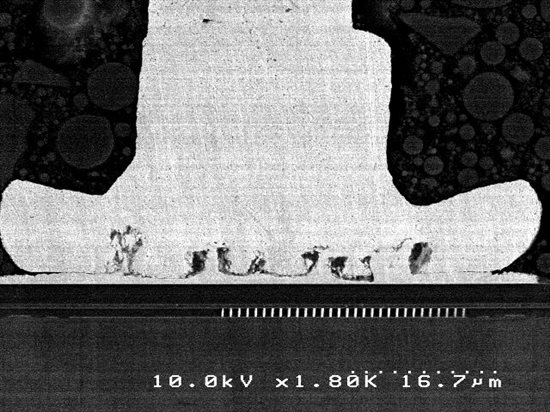In my last blog post, Turn up the heat, we talked about high temperature flash memory and the need for electronics in very harsh environments. One of the biggest areas of concern for product designers is the functionality of the parts at extreme temperatures and finding the right packaging. When temperatures reach 200°C plus you’ll want packaging options that can withstand the heat to protect your parts!
There are several reliability concerns with plastic packages at very high temperatures, including:
- Kirkendall Voiding - A standard plastic package typically uses gold bond wire to connect to the aluminum bond pads of the die. When exposed to higher temperatures, the diffusion of the Al pad into the gold ball bond causes voids in the ball weld that gets worse with time. Eventually, the weak bond can lift. The intermetallic diffusion is also called Kirkendall voiding and the increased electrical resistance and weakened bond interface can lead to failure of the device.
- Material Decomposition - A standard mold compound can also weaken over time at higher temperatures than specified and decompose leading to corrosion and bond wire damage.
- Delamination - Delamination is also a problem when there is increased thermo-mechanical stress leading to bonds being lifted. Lead and Die attach delamination can also happen with standard commercial materials at extreme temperatures or with many thermal cycles.
Figure 1. Cross section of Au ball bond with intermetallic voiding
Many standard plastic encapsulated parts are qualified up to 125°C and are used for a wide variety of industrial and automotive applications. But, when exposed to temperatures higher than 125°C these standard packages may not be suitable for reliable operation and other package options need to be evaluated.
Below are some extended temperature packaging solutions to consider for high temperature plastic, ceramic, and bare die packaging:
- HT Plastic: -55°C to 150-175°C/. These parts use new material sets specific for high temperature operation including leadframe, mold compound, die attach, and bond wire. TI uses special optimized bond processes to help eliminate the intermetallic issue on bond pads.
- Ceramic: -55°C to 210°C.These devices use the most rugged, hermetic ceramic packaging to support temperatures above 200°C. The use of aluminum wire eliminates many concerns of the gold wire bonding.
- Known Good Die (KGD): -55°C to 210°C.KGD provide the smallest form factor of fully tested and qualified devices for applications that need to integrate into multi-chip modules or hybrids.
The typical process to build high temperature electronics requires you to purchase industrial, automotive, and military-specific temperature parts. Then you have to extensively qualify for temperatures above 125°C, and finally screen every device for use in the system. This is very costly and a time consuming process. If you’re designing for high temperatures, there are a number of catalog parts tested and guaranteed to perform at temperatures higher than 150°C. Below are a few I think are worth highlighting that may help in your design. Depending on your application and requirements for ruggedizing your end equipment, there are also now a number of semiconductor packaging options from TI that can support your specific requirements.
Signal conditioning
- INA128-HT: Low power instrumentation amplifiers
- THS4521-HT: Low power differential amplifier
Data converters
- ADS1278-HT: Octal, 24-bit analog-to-digital converter
- ADS8509-HT: 16-bit 250kHz CMOS analog-to-digital converter with serial interface
Interface
- SN65HVD1040-HT: 5-V CAN transceiver
- ISO7221C-HT: Dual channel, 1/1, 25Mbps digital isolator
Power
- TPS54362-HT: 1-A 48-V step down DC/DC converter with Low Iq
- TPS40200-HT: Wide input buck DC/DC controller
- TPS62110-HT: 17-Vin, 1.5-A, synchronous step-down converter
Microcontrollers / Processors
- MSP430F2619S-HT: 16-bit ultra-low power MCU (150°C max)
- OMAPL137-HT: Low power dual-core processor (ARM9+DSP max)
If you need even more options or want info on high temperature devices and packaging come visit us here.

